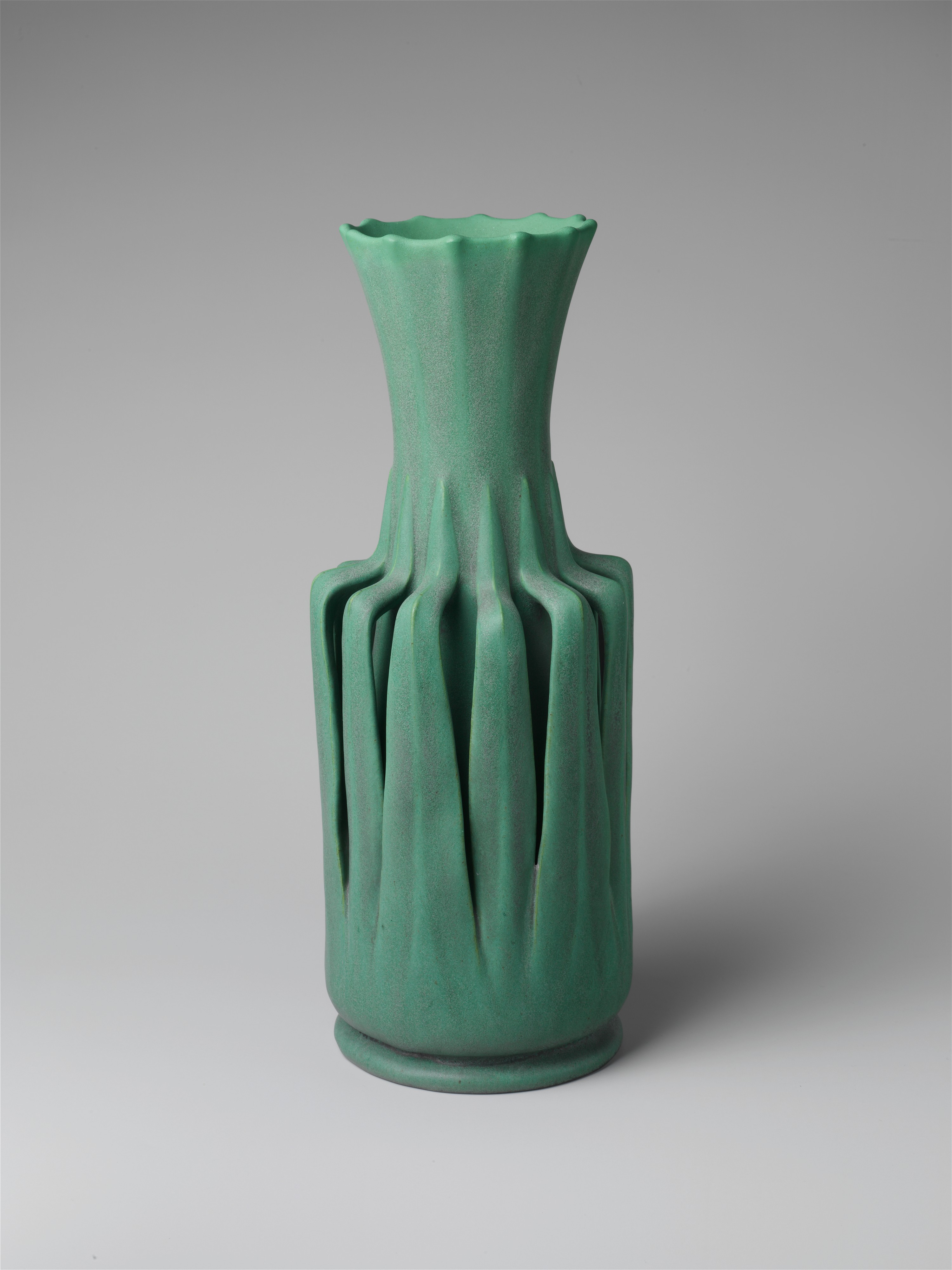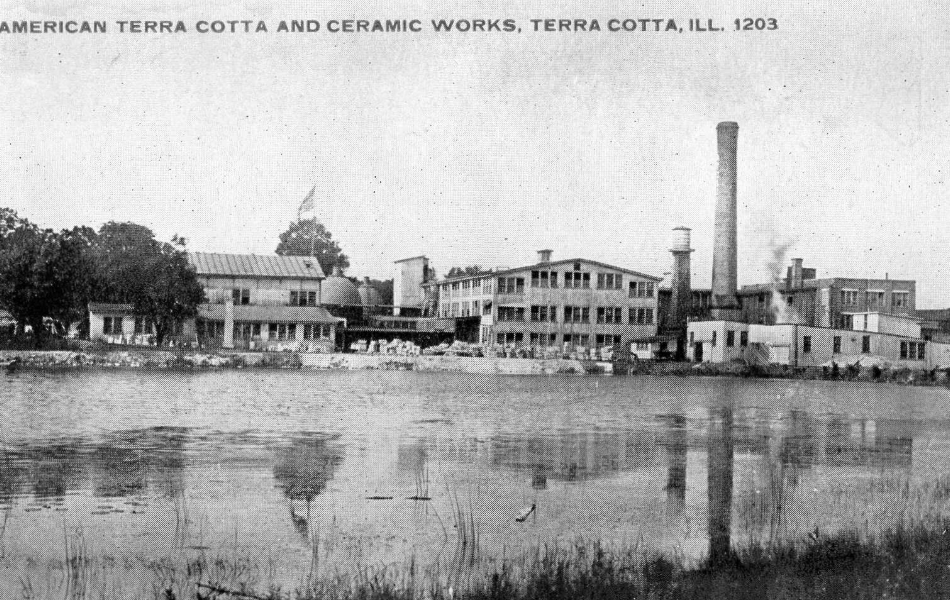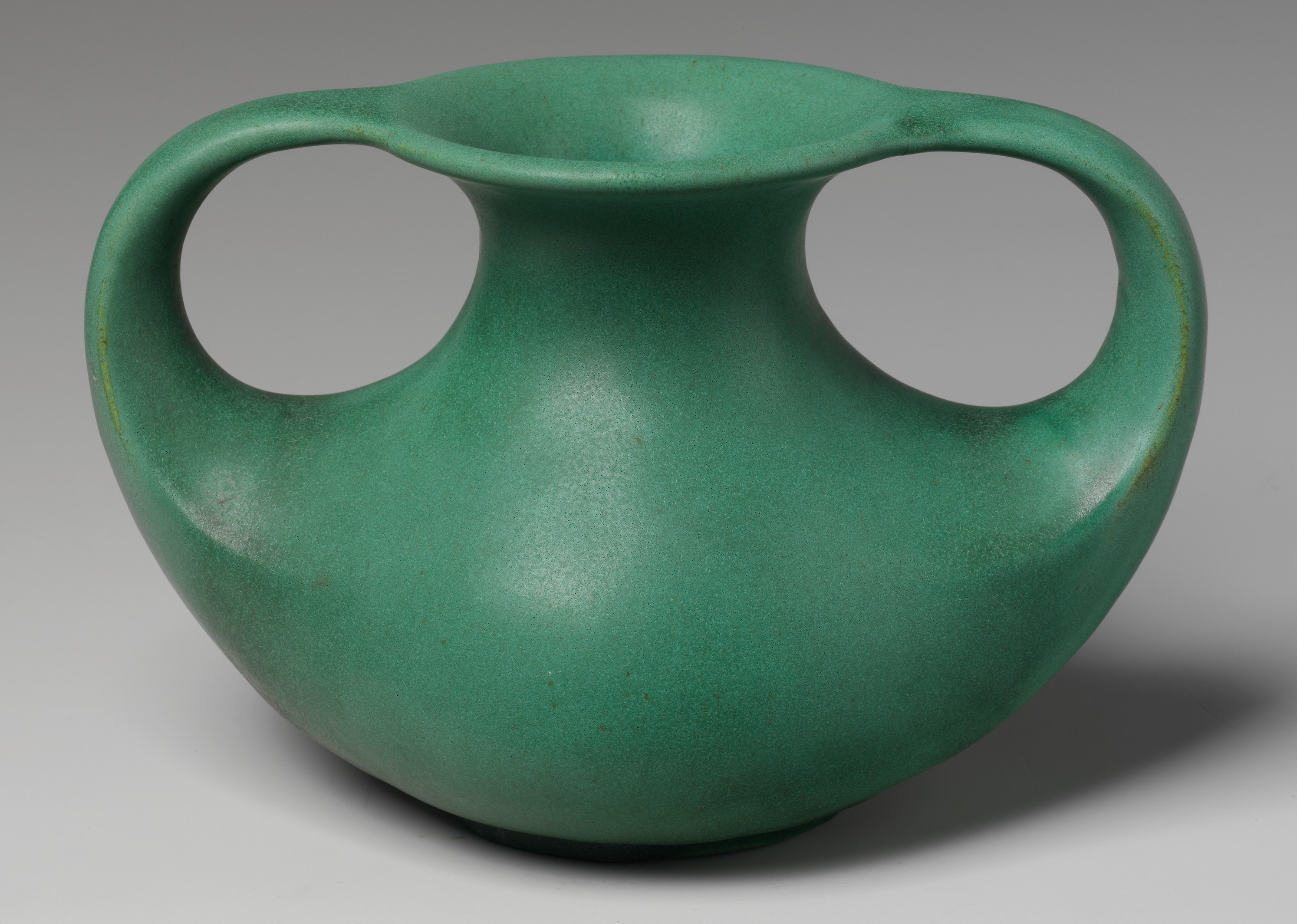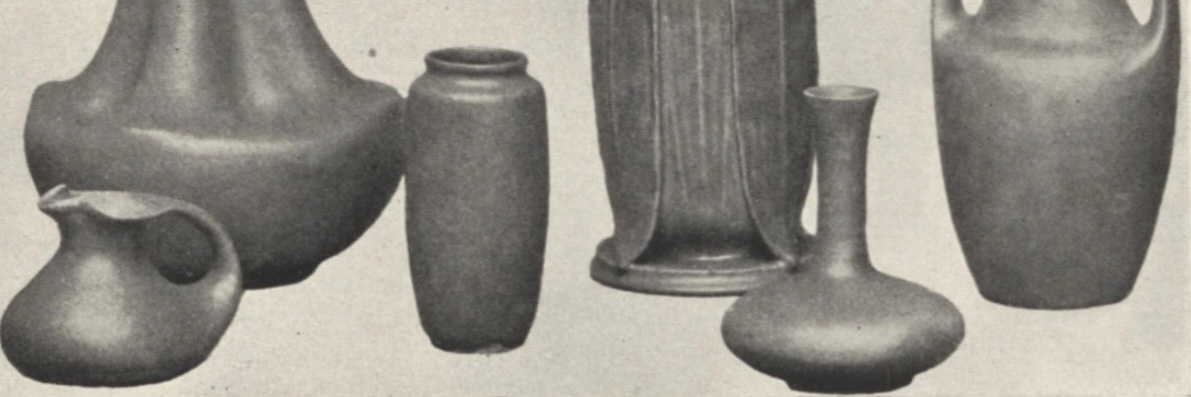“Clayworking led not only to the making of clay wares, but to the making of men as well.”
During the late 1800’s, in a factory on the shores of Crystal Lake, Illinois, William Gates embodied these words with the creation of The American Terra Cotta & Ceramic Company. Gates, who had grown up in Crystal Lake and had become an attorney in Chicago, returned home after the death of his father and invested in ceramic tile ware. 2 Over time he began producing terra-cotta building materials for construction use. Since terracotta is fireproof, it was in high demand after the Great Chicago Fire of 1871, and Gates found success in selling to Midwestern architects. 3 Over time, and with the help of Prairie School designers who bought materials from him, including such luminaries as Frank Lloyd Wright, Gates began producing art pottery in his factory.
These artfully designed pots, made from the same terra-cotta clay as the firm used for its construction materials, was dubbed Teco pottery. It had a distinctive style. Where other forms of art pottery relied on glazing and intricate surface design to achieve distinctiveness, Teco pottery used form: buttresses, curves, and spirals that mirrored Prairie Style architecture and showed the influence of the natural world, with a unique green matte glaze.

Large vase with leaf like detailing. Image courtesy of Wikimedia Commons.
Prairie School design was not the only cultural influence on Teco. Through moving away from industrialization and instead emphasizing the importance and value of more traditional handcrafted products, Teco also embraced the Arts and Crafts movement. This blend of craft and artistry with modern, geometric, and flat designs was incredibly original and quintessentially American. This innovation also came from Teco’s connection to the prairie landscape, reflecting the expansive and horizontal environment through pottery. Structures designed by Prairie School architects blended the natural world with the indoors through their emphasis on light and earthen colors.
Gates incorporated these two philosophies into Teco art ware as well as in his factory. While the original designers of Teco pots made them by hand, Gates would then have them molded and mass produced in the factory. The workers who produced these pots often had no previous experience in ceramics, but it was important to Gates that they cared about their work. He landscaped the factory grounds, even putting in a lily pond for his employees. As Susan Frackleton, a well-known potter who visited the factory, once said, Gates fundamentally believed that “beautiful surroundings inspire beautiful thoughts.” 6 He also believed that working with one’s hands to create on a smaller scale was morally superior to work in industrialized and impersonal factories, and therefore that handcrafted work was beneficial to both the individual and society as a whole. While in many ways he embodied the idealistic vision of the Arts and Crafts movement, Gates once fired a worker for trying to unionize, showing that he wasn’t entirely aligned with the socialist movement.

American Terra Cotta Factory. Image courtesy of the Crystal Lake Historical Society.
Gates believed that creating accessible Teco art ware, ranging from small pots to large intricate vases, was a way to brighten and improve the homes of Americans. The factory applied the same system to Teco pottery that was used to mass produce architectural terracotta. Because of this, Teco was largely available and affordable to most Americans. Two advertisements from that time read, “Teco is really the harmonic and intelligible voice of America at her best–-a divine melody of curve and color…We are privileged among many generations; we have been at the birth of a new and everlasting classic.” 7 Gates marketed his pottery as a reflection of American culture. The ads clearly express how he wanted these products to be available and appealing to everyone. Although Teco pottery was revolutionary in its day, it is not currently well-known, especially when compared to Prairie School architecture, which enjoys wide public recognition. This is especially surprising because some scholars and artists believe that Teco’s emphasis on form anticipated a lot of modern art, some even suggesting that it was a beginning to the modern art movement 8. Perhaps it is for this reason that Teco pottery today sells for thousands of dollars.

Vase with two curved handles. Image courtesy of Wikimedia Commons.
A newspaper from 1915, the Crystal Lake Herald, states that the American Terra Cotta & Ceramic Company was “a melting pot where the knowledge of all that is finest in art and architecture, chemistry and science, is through the magic touch of genius, transformed into building materials and pottery that rank among the highest examples of ceramic art.” 9 As was clearly recognized at the time, Teco is incredibly special. In its unique design and through the melding of the Arts and Crafts Movement and American Industrialism, Gates and his employees innovated American art pottery, right here on the prairie.
It is fitting that these pieces are made from terracotta, a durable and strong material. Despite being less known, its impact on art and the household endures. Today, ceramics are important both practically and aesthetically in the home. While surface design is still popular, modern ceramics embrace form and single-color glaze.
Teco pottery was discontinued in the 1930’s after Gates retired and the factory struggled through the Great Depression
10. Nevertheless, William Gates’ desire to brighten people’s homes with his pottery is a lasting legacy of his vision and the Prairie Style.
1 Artner, A. G. (1989, Nov 12). Prairie pottery: Humble Teco pots were inspired by lofty ideals. Chicago Tribune (1963-1996) https://grinnell.idm.oclc.org/login?url=https://www.proquest.com/historical-newspapers/prairie-pottery/docview/1019125895/se-2
2 American Terra Cotta. American terra cotta – crystal lake historical society. (n.d.). https://cl-hs.org/local-history/businesses/american-terra-cotta/#:~:text=A%201915%20Crystal%20Lake%20Herald,among%20the%20highest%20examples%20of
3 Darling, S. S., & Zakin, Richard. (1989). Teco : art pottery of the Prairie School. Erie Art Museum, 15.
4 Artner, A. G. (1989, Nov 12). Prairie pottery: Humble Teco pots were inspired by lofty ideals. Chicago Tribune (1963-1996) https://grinnell.idm.oclc.org/login?url=https://www.proquest.com/historical-newspapers/prairie-pottery/docview/1019125895/se-2
5 Darling, S. S., & Zakin, Richard. (1989). Teco : art pottery of the Prairie School. Erie Art Museum, 35.
6 Darling, S. S., & Zakin, Richard. (1989). Teco : art pottery of the Prairie School. Erie Art Museum, 36.
7 Darling, S. S., & Zakin, Richard. (1989). Teco : art pottery of the Prairie School. Erie Art Museum, p.51.
8 Darling, S. S., & Zakin, Richard. (1989). Teco : art pottery of the Prairie School. Erie Art Museum, p.8.
9 American Terra Cotta. American terra cotta – crystal lake historical society. (n.d.). https://cl-hs.org/local-history/businesses/american-terra-cotta/#:~:text=A%201915%20Crystal%20Lake%20Herald,among%20the%20highest%20examples%20of
10 About Teco Pottery. Just Art Pottery. (n.d.). https://justartpottery.com/pages/about-teco-pottery


